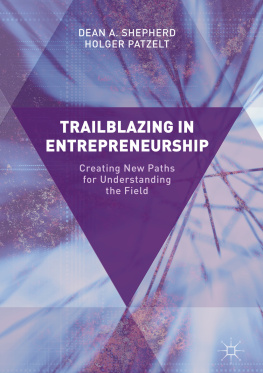1. The Importance of Trailblazing Scholarship for Understanding Entrepreneurship
Do not go where the path may lead; go instead where there is no path and leave a trail.
Ralph Waldo Emerson
Recently, the co-authors of this book met in Blairgowrie, Australia. Dean Shepherd showed Holger Patzelt the Back Beach where he had spent much of his youth. Dean recalled his childhood taking the trek from his house along the path through the coastal reserve to the rock pool and surf:
Although the path made the trip relatively quick, easy, and safe, it was a somewhat boring walk. Sometimes my brother and I took a narrower path to see a less populated section of the beach, and other times, we created our own patha route that no one else had taken. We called it bushwhacking because we had to beat our way through the dense tea-tree. We did this to explore. This new path was always slower than the normal route as well as less comfortable (with branches scratching and long grasses poking) and less safe (with the chance of coming across poisonous snakes and/or spiders), but we did it anyway. We held out hope this new path would lead to a new sand dune we could tumble down, a new vista we could appreciate, a cave to hide in, or a rock pool within which we could dive and swim. But even when we did not find one of these desirable outcomes and spent hours walking only to find that we had returned to our original starting point, we had enjoyed every minute of it.
This description of bushwhacking is the Australian version of trailblazing, and metaphorically, entrepreneurs can also be trailblazers make a path through new or unsettled terrain upon which others may follow . That is, rather than follow the established path created by others, entrepreneurs often challenge the status quo by attempting to chart a new direction through the creation of new products, services, and/or processes. However, this book is not about trailblazing in coastal reserves or in product markets but about trailblazing in the field of entrepreneurship. We believe that scholars can be trailblazers, and in doing so, they can create new knowledge that others can build on to create additional knowledge and inform practice. Although this trailblazing may not have to deal with the poisonous snakes and spiders of Australia, it certainly has its fair share of obstacles, requires considerable effort, and may also lead to dead ends. Along with the challenges of creating a new trail are the intrinsic rewards from the process and the extrinsic rewards from the outcomes of making substantial contributions to knowledge. For scholars traveling along a well-worn path or a semi-worn path, the research outcomes are replication and incremental research, whereas trailblazing creates new knowledge through more radical ideas. Important in trailblazing is knowing where to start and having some knowledge about the terrain to be covered, the tools to help clear the path, and the potential gems that might be encountered along the way. The purpose of this book is to provide some insights into where trailblazing may be best directed, how, and with what potential outcomes. Specifically, this book offers a series of frameworks from which or within which we believe important research will emergeresearch that will have a substantial impact on our understanding of an entrepreneurial phenomenon and, thus, on the way we progress with subsequent entrepreneurship research.
We emphasize trailblazing (as opposed to taking existing paths) because we strongly believe that the future of the entrepreneurship field is promising but only if our research itself continues to be entrepreneurial. That being said, continuing to be entrepreneurial in our research may be more difficult than it initially appears. The success we have had thus far may lead us into a competency trap (Levitt & March,
As we consider the entrepreneurship fields future, our goal with this book is not to decry or replace Venkataramans (Shane & Venkataraman, ) description of entrepreneurships characteristic domain with our own; rather, our goal is to illuminate areas of unsettled terrain worthy of trailblazing work as a basis for the vitality of the fields future. Such trailblazing is likely to continuously alter what is considered to be entrepreneurship. As researchers, we should maybe focus less on whether our current work conforms to published domain statements within the entrepreneurship field because the field itself has likely already shifted. Our current work may make a more substantial contribution to the field by expanding its boundaries further by, for instance, opening up new terrain that then becomes part of the field of entrepreneurship (in retrospect).
Indeed, researchers from a variety of fields tend to focus narrowly on prevailing principles and themes, which can homogenize knowledge creation (in the literature) about the diverse world (Glynn, Barr, & Dacin, ) bemoaned that entrepreneurship research occasionally suffers from an abundance of studies articulated on different core principles and assumptionsa practice that has resulted in slow knowledge accumulation in the field. These arguments are consistent with those for the benefits of well-established paths.
While there is a great deal of value in knowledge-accumulation arguments, this paradigm-development approach seems to prefer parsimony and consistency above depth and diversity. As a result, this approach has the potential to generate an exceedingly narrow view (Burrell & Morgan, , p. 672)all with the aim of winning the paradigm war. In this context, the more exploratory is overtaken by the more exploitive. Indeed, this mindset is like putting up wire fences to dissuade people from leaving the path to create their own.
Entrepreneurship and Beyond
Although our primary intent with this book is to advance the field of entrepreneurship (without specifying the domain of entrepreneurship), we are conscious that in doing so, we have an opportunity to make contributions to knowledge that also advance other fields. Indeed, in many instances throughout the book, we focus our attention at the boundaries of current entrepreneurship theories, particularly constructs and relationships in the gray area between overlapping paradigms, levels of analysis, and fields of knowledge. This focus provides a systematic search, the search of known information sources (see Fiet, ]).
Potential Research Opportunities and Research Methods
The precursor to this book was the Party On paper (Shepherd, ). We are agnostic about research methods. Rather, we are pluralistic. We believe that the appropriateness of a particular research method depends on the research question and likely the knowledge and motivation of the researcher. It could be that multiple methods could be used to approach the same research opportunity, although it is likely that the operationalizations, sample context, and so forth may be so different such that they represent a different (but related) research opportunity; one that may be complementary in knowledge production. This is a good thing. Consistent results provide confidence in our knowledge based on replication. Differences in results signal the need for additional theorizinga win-win.
Although the above assumes that the new content of our theorizing on an entrepreneurial phenomenon can be tested using (multiple) established research methods, we recognize that some research questions and/or conjectures may require the creation of new methodsnew to entrepreneurship but established elsewhere, new combinations of multiple methods, or the creation of new to the world methods. However, the creative process does not necessarily need to be from content to method; it could be the other way around. As new methods are developed and introduced, we believe that they will open up new conceptual domainsnew methods lead to new content. Therefore, although we focus on the importance of being entrepreneurial in our theorizing for advancing the field, we also recognize the importance of being entrepreneurial in our methods and welcome such advancements.












